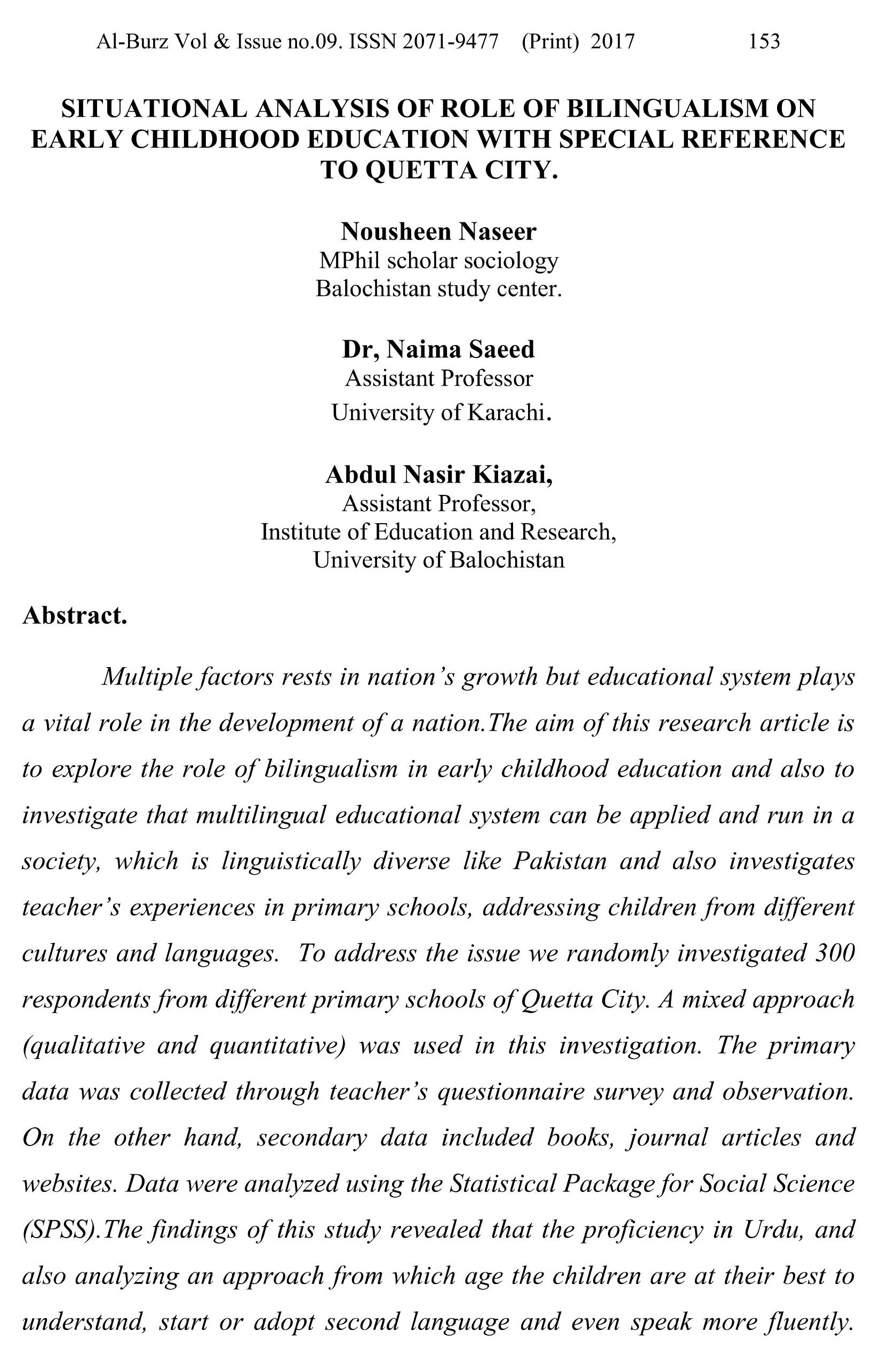SITUATIONAL ANALYSIS OF ROLE OF BILINGUALISM ON EARLY CHILDHOOD EDUCATION WITH SPECIAL REFERENCE TO QUETTA CITY.
DOI:
https://doi.org/10.54781/abz.v9i1.109Keywords:
Bilingualism, Early childhood, Education, Quetta cityAbstract
Multiple factors rests in nation’s growth but educational system plays a vital role in the development of a nation. The aim of this research article is to explore the role of bilingualism in early childhood education and also to investigate that multilingual educational system can be applied and run in a society, which is linguistically diverse like Pakistan and also investigates teacher’s experiences in primary schools, addressing children from different cultures and languages. To address the issue, we randomly investigated 300 respondents from different primary schools of Quetta City. A mixed approach (qualitative and quantitative) was used in this investigation. The primary data was collected through teacher’s questionnaire survey and observation. On the other hand, secondary data included books, journal articles and websites. Data were analyzed using the Statistical Package for Social Science (SPSS).The findings of this study revealed that the proficiency in Urdu, and also analyzing an approach from which age the children are at their best to understand, start or adopt second language and even speak more fluently. Pertinently that is the age it can also be judged the children are mixing up the primary and secondary languages. The findings of the study reveals that 52.7% respondents were excellent in Urdu language, 46.7 % respondent suggested the best age of 4-6 year to start the second language, 59% respondents were of the view that children can mix-up primary and secondary languages. 61.3% agreed upon the bilingualismin theearly ages. The survey concludes the bilingualism can effect on the education of the children at early age. Keeping in view the multilingualatmosphere of the Quetta city it is recommended that monoligualism is the best option of the children to be adopted in education system for better understanding.
References
Ball, J. (2010). Enhancing learning of children from diverse language backgrounds: Mother tongue-based bilingual or multilingual education in early childhood and early primary school years. Victoria, Canada: Early Childhood Development Intercultural Partnerships, University of Victoria.
Cummins, J. (2001). Bilingual children’s mother tongue: Why is it important for education. Sprogforum, 19, 15-20.
Chomsky, N. (2002). Syntactic structures. Walter de Gruyter.
Lee, P. (1996). Cognitive development in bilingual children:
A case for bilingual instruction in early childhood education. Bilingual Research Journal, 20(3-4), 499-522.
Manan, S. A., David, M. K., &Dumanig, F. P. (2015). Disjunction between language policy and children's sociocultural ecology–an analysis of English-medium education policy in Pakistan. Language and Education, 29(5), 453-473.
Patrinos, H. A., &Ariasingam, D. L. (1997). Decentralization of education: Demand-side financing (Vol. 292). World Bank Publications.
Rahman, T. (2010). National Institute Of Pakistan Studies October 2010.
Martin-Jones, M., &Saxena, M. (2003). Bilingual resources and'funds of knowledge'for teaching and learning in multi-ethnic classrooms in Britain. International Journal of Bilingual Education and Bilingualism, 6(3-4), 267-282.
Cummins, J. (2007). Rethinking monolingual instructional strategies in multilingual classrooms. Canadian Journal of Applied Linguistics/Revue canadienne de linguistiqueappliquée, 10(2), 221-240.
Baker, C., & Jones, S. P. (Eds.). (1998). Encyclopedia of bilingualism and bilingual education. Multilingual Matters.
Miles, C. (1996). Bilingual Children in Special Education: Acquisition of Language and Culture by British Pakistani Children Attending a School for Pupils with" Severe Learning Difficulties.".

Downloads
Published
How to Cite
Issue
Section
License
Copyright (c) 2017 Authors who publish with Al-Burz journal agree to the following terms: 1. Authors retain copyright and grant the journal right of first publication with the work simultaneously licensed under a Creative Commons Attribution (CC-BY) License that allows others to share the work with an acknowledgement of the work's authorship and initial publication in this journal. 2. Authors are able to enter into separate, additional contractual arrangements for the nonexclusive distribution of the journal's published version of the work (e.g., post it to an institutional repository or publish it in a book), with an acknowledgement of its initial publication in this journal.

This work is licensed under a Creative Commons Attribution-NonCommercial-ShareAlike 4.0 International License.
Alburz has licensed under a CC Attribution-NonCommercial-ShareAlike 4.0



